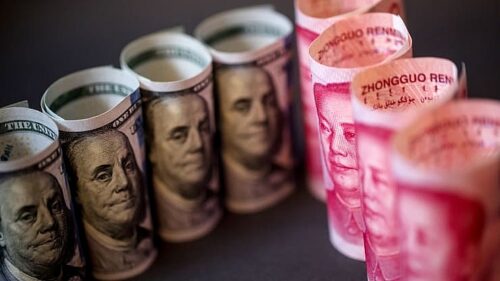>>REAL-TIME UPDATES IN THE WIRE. CLICK HERE<<<
The People’s Bank of China (PBOC) on Monday announced a cut to reserve requirement for financial institutions’ foreign exchange deposits by 2 percentage points after the yuan weakened more than 2.8% agains the US dollar in three weeks to hit the weakest level in two years.
In order to increase financial institutions’ ability to use foreign exchanges, the reserve requirement ratio (RRR) on forex deposits at financial institutions, or the amount of forex reserves that banks must hold, will be lowered from 8% to 6%, effective from September 15, the central bank said in a statement.
That marks the second cut to banks’ forex reserve requirement ratio this year and the ratio has so far bee cut by a total of 3 percentage points this year.
Earlier on the day, Liu Guoqiang, deputy governor of the PBOC, said at a press briefing earlier on Monday that “we would like to see the yuan’s exchange rate stay steady around a reasonable and balanced level and we have the ability to support the currency at the level.”
As of the end of June, Chinese financial institutions’ outstanding foreign exchange deposits stood at $986.7 billion and the 2-percentage point cut to forex reserve requirement ratio will release nearly $20 billion liquidity.
Market observers say that the move won’t have significantly impact on the market and the PBOC’s move is aimed at sending a signal to the market.
“The PBOC has been using the forex deposit RRR as a macro prudential measure and the adjustment to the ratio will send a signal about the authority’s intention to stabilize the currency,” said Guan Tao, a former official at the State Administration of Foreign Exchanges (SAFE) and currently chief global economist at BOC International.
Since August 15, the yuan has weakened sharply against the greenback by about 2.8% from around 6.75 per dollar. On Monday, the yuan’s daily fixing was cut by 81 pips to 6.8997 per US dollar. The onshore yuan broke through 6.92 per US dollar shortly after market open on Monday morning and hit 6.9435 per dollar at one point and the offshore yuan hit 6.9550 per US dollar at one point, the weakest level in two years.
After the PBOC’s announcement about forex RRR cut, the offshore yuan surged by nearly 200 pips to returned to around 6.93 per US dollar.
Liu Guoqiang said at the press briefing that the Chinese yuan has been under pressure mainly due to the monetary tightening in the US which sends the US dollar index soaring. “Given the strengthening greenback, other reserve currencies in the International Monetary Fund’s Special Drawing Rights basket have all depreciated sharply against the greenback. Compared with other non-US dollar currencies, the yuan has depreciated the least.”
Driven by the Euro’s depreciation and the Federal Reserve’ hawkish policy, the US dollar index jumped above 110 mark on Monday and hit as high as 110.28, bringing its total gains since August 15 to more than 4.3%.
During the same period, the yuan’s exchange rates against other major currencies were largely stable and the CFETS index actually rose to 102.02 on September 2 from 101.88 on August 15.
“China’s foreign exchange market is currently operating normally with orderly cross-border capital flows and the spillover effect from US monetary policy remains controllable,” said Liu. That’s due to the strong resilience of China’s economy, and the resilience of the foreign exchange market has also been much enhanced by exchange rate system reforms, he added.
“From a long-term perspectively, the world’s recognization of the yuan is increasing, but in the short term, two-way fluctuation will be a normal and there won’t be any one-way movement,” said Liu.
China has effectively coordinated anti-Covid-19 measures and economic development to maintain growth, enabling the country to roll out an ordinary monetary policy without over-issuing currency, Liu said, adding that China has ample monetary policy room, with plenty of tools.

